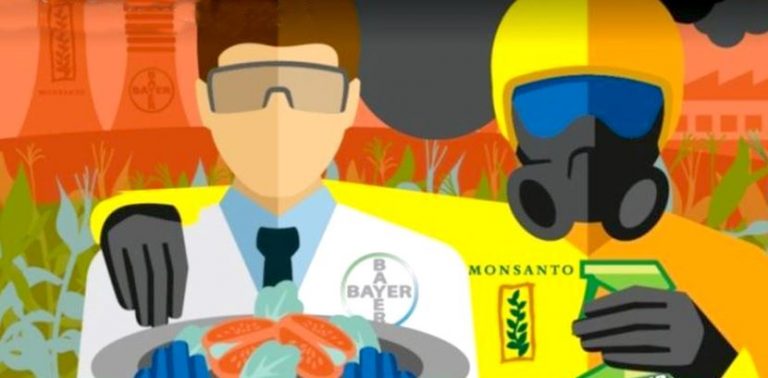
Bayer is expected to finish off its $62.5 billion purchasing deal with Monsanto this week — and plans to retire the infamous “Monsanto” name are already in gear. But even if the name Monsanto becomes a thing of the past, the company’s dirty deeds and hazardous products will continue to live on.
Bayer certainly knows a thing or two about re-branding to save face; once known as I.G. Farben, the company engaged in a number of disgusting acts back in the day, including using Jewish slave laborers during the Holocaust. Changing their name to Bayer has not mitigated this fact — though it certainly has helped the company remain profitable.
It’s sadly almost fitting that these two companies have ended up together, as both Bayer and Monsanto have a history of committing crimes against humanity. Unfortunately, this wicked pairing will spell disaster for the rest of us.
Changing names means nothing
As the merging of Bayer and Monsanto draws closer, Bayer has revealed that once combined, the name Monsanto will cease to exist. Instead, Monsanto and its products will simply become part of the Bayer “family.”
But will relabeling Roundup as a Bayer product change the fact that it’s toxic and makes people sick? No. Will the independent media suddenly stop reporting on their cancer-causing glyphosate and pernicious GMO products? Absolutely not. Monsanto may disappear in name, but its legacy of toxicity and disregard for human life will unfortunately live on — and people are right to be worried about what comes next.
100% organic essential oil sets now available for your home and personal care, including Rosemary, Oregano, Eucalyptus, Tea Tree, Clary Sage and more, all 100% organic and laboratory tested for safety. A multitude of uses, from stress reduction to topical first aid. See the complete listing here, and help support this news site.
While the name Bayer may not currently draw as much ire as the name Monsanto does, it should — and perhaps one day it will. The Bayer company’s history is just as sordid and twisted as Monsanto’s, after all.
Over 20 years ago, Helge Wehmeier, then-head of Bayer Corp, publicly apologized to the late Elie Wiesel and other Holocaust survivors for the egregiously inhumane actions of I.G. Farben.
“I have sorrow and regret and apologize for the inhumanity in my country for what I.G. Farben did to your people,” Wehmeier said to Wiesel during a lecture in 1995. Wiesel was one of many Jewish slave laborers used by the company during the Holocaust. The company was also reportedly heavily invested in the development of Zyklon B, a toxic insecticide.
Bayer’s dark past
I.G. Farben scientists also conducted experiments on their captive slaves. In 2003, Holocaust survivor Zoe Polanska Palmer spoke out about her experiences as a Nazi test subject. Many SS doctors reportedly worked for Bayer’s parent company, I.G. Farben, including Dr. Victor Capesius and Dr. Helmut Vetter — both of whom were tried and convicted for various war crimes, with the latter being executed after the war. Capesius, Polanska Palmer says, is the doctor who experimented on her, and witnesses say he worked for Bayer.
Ms. Polanska Palmer was not alone; countless children were reportedly abducted and experimented on. In the late 1990’s, Eva Mozes Kor launched her own lawsuit against Bayer, claiming that the company supervised the purchasing of her and her twin from Nazis and that they were then used as “guinea pigs” by the infamous Josef Mengele. Kor alleges that she and other children were purposely infected with a host of diseases “to test the effectiveness of various drugs manufactured by Bayer.”
Ms. Kor stated at the time, “After 54 years, it is time that Bayer takes responsibility for their actions.” In addition to financial restitution, Kor said she wants to hear an actual apology. While Bayer has admitted to the use of slave labor, the company has not readily disclosed the other acts of evil their parent company was involved in.
In 2003, in response to Ms. Polanska Palmer’s claims, Bayer contended that the name Bayer didn’t even exist between 1925 and 1952, and so, the company we know today had nothing to do with I.G. Farben. Really?
As sources explain, I.G. Farben has never truly stopped existing. Even though the Allies broke up the company due to their evil and inhumane activities, it simply became three new companies: Bayer, Hoechst and BASF. As of 2012, I.G. Farben still existed as a company in liquidation.
Is Bayer really as far removed from I.G. Farben as it claims to be?
Sources for this article include:
NYDailyNews
Axios
NPR.org
